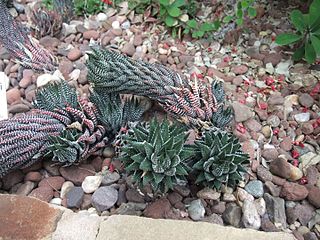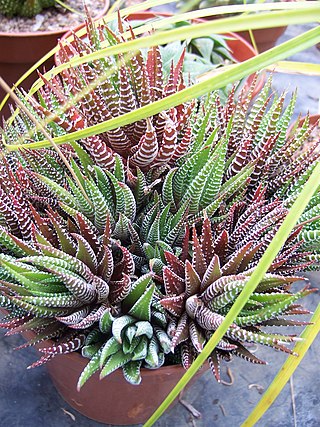
Haworthia is a large genus of small succulent plants endemic to Southern Africa (Mozambique, Namibia, Lesotho, Eswatini and South Africa).

Gasteria is a genus of succulent plants, native to South Africa and the far south-west corner of Namibia.

Haworthiopsis coarctata, formerly Haworthia coarctata, is a species of flowering succulent plant from the Eastern Cape Province, South Africa and naturalized in Mexico. It is one of the species of Haworthiopsis that is commonly cultivated as an ornamental.

Haworthiopsis reinwardtii, formerly Haworthia reinwardtii, is a species of succulent flowering plant in the family Asphodelaceae, native to the Eastern Cape Province of South Africa. It is one of the species of Haworthiopsis that is commonly cultivated as an ornamental.

Gasteria armstrongii is a dwarf succulent plant native to South Africa, in the genus Gasteria.

Kumara plicatilis, formerly Aloe plicatilis, the fan-aloe, is a succulent plant endemic to a few mountains in the Fynbos ecoregion, of the Western Cape in South Africa. The plant has an unusual and striking fan-like arrangement of its leaves. It may grow as a large multistemmed shrub or as a small tree. It is one of the two species in the genus Kumara.

Haworthia truncata, locally known as horse's teeth, is a species of succulent plant in the genus Haworthia. It is found in the Little Karoo region, in the far east of the Western Cape Province, South Africa.

Haworthiopsis attenuata, formerly Haworthia attenuata, commonly known as zebra haworthia, is a small species of succulent plant from the Eastern Cape Province, South Africa. As an ornamental, it is one of the most commonly cultivated of the Haworthiopsis species.

Crassula ovata, commonly known as jade plant, lucky plant, money plant or money tree, is a succulent plant with small pink or white flowers that is native to the KwaZulu-Natal and Eastern Cape provinces of South Africa, and Mozambique; it is common as a houseplant worldwide. Much of its popularity stems from the low levels of care needed; the jade plant requires little water and can survive in most indoor conditions. It is sometimes referred to as the money tree; however, Pachira aquatica also has this nickname.

Gasteria acinacifolia, the dune gasteria, is succulent plant native to the Eastern Cape Province, South Africa.

Gasteria disticha is succulent plant native to the Western Cape, South Africa.

Gasteria pillansii, the Namaqua gasteria, is succulent plant native to the arid winter-rainfall regions in the far west of South Africa and Namibia.

Gasteria bicolor is a species of succulent flowering plant in the family Asphodelaceae, native to the Eastern Cape, South Africa.

Gasteria nitida, the Bathurst gasteria, is a succulent plant, native to the Eastern Cape grasslands of South Africa.

Gasteria batesiana, or knoppies gasteria, is a species of succulent plant native to the inland escarpment in the far north-east of South Africa.

Gasteria carinata, commonly called Bredasdorp gasteria or keeled gasteria, is a small and variable succulent plant native to the Western Cape Province, South Africa.

Gasteria brachyphylla, the Klein Karoo gasteria, is succulent plant native to the Western Cape, South Africa.

Gasteria croucheri, or Natal gasteria, is a succulent plant native to KwaZulu-Natal Province, South Africa.

Gasteria glauca, the Kouga gasteria, is a succulent plant of the family Asphodelaceae native to the cliffs and rocky hillsides above the Kouga River, in the Eastern Cape, South Africa. It is most closely related to the species G. ellaphieae, G. vlokii and G. nitida. The flowers of all four species are also nearly identical, displaying the signature “gastric”, stomach-shaped blossoms that earn the genus the name of Gasteria. The blossoms are a favorite among pollinators, such as bees, lepidopterans, hoverflies, hummingbirds and sunbirds.

Orbea variegata is a species of flowering plant in the family Apocynaceae, known as the star flower. It is native to the coastal belt of the Western Cape, South Africa, growing actively during the winter rainfall season. It is an invasive species in southern Australia.




















